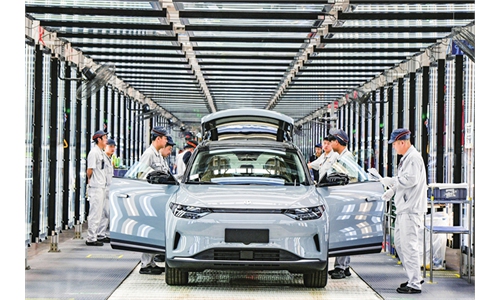Philippine ship may 'cause irreversible damage to marine life'
https://youtube.com/shorts/kHVYgfys70E?si=LJx3spoWSkZWVl9z
Photo: China Coast Guard
The hull and interior facilities of the illegally grounded Philippines' warship at Ren'ai Jiao (also known as Ren'ai Reef) are severely corroded, showed a set of images exclusively obtained by the Global Times from the China Coast Guard (CCG) recently.
Experts warned that the illegally grounded warship may cause irreversible and continuous damages to the marine life in the South China Sea.
Since 2023, the Philippines has acted in bad faith, and secretly supplied construction materials to the grounded warship through various means. The Philippines' repeated supplements fully exposed its intention to blatantly violate its promise to tow away the warship, and its attempt to illegally occupy China's Ren'ai Jiao with malicious intent.

Photo: China Coast Guard
The exclusive images obtained by the Global Times from the CCG show that the hull of the illegally grounded warship has damage and leaks, with a large amount of paint peeling off the hull, and many corroded rusts water directly flowing into the sea. The entire ship has almost become a pile of rusty scrap iron, with various personal items and garbage casually placed on the uncovered deck.
Filipino military personnel are fishing on the shallow reef of Ren'ai Jiao. One of the images shows a Filipino military personnel is standing on the grounded warship and is suspected of urinating into the lagoon of Ren'ai Jiao.
The illegally grounded warship looks actually to be no longer suitable for human habitation and living.

Photo: China Coast Guard
Several video clips captured earlier this year show that Filipino military personnel on the grounded warship not only dumped waste water directly into the sea, they also gathered on the foredeck to burn garbage. The actions of the Filipino military personnel have starkly contrasted with the pristine blue skies and clean waters near Ren'ai Jiao, showing their destruction of the marine environment.
Facing such a dilapidated warship, the Philippine authorities have repeatedly violated their promises. Instead of towing away the illegally grounded military vessel, they have attempted to carry out large-scale repairs and reinforcements on it. The transportation has been reinforced since last year.

Photo: China Coast Guard
An anonymous professional told the Global Times that since 2023, the Philippines has repeatedly illegally intruded into China's Ren'ai Jiao, and carried out illegal resupply activities for the warship. In addition to the malicious provocations, the reason behind this is that the warship is severely damaged, and the Philippines needs to resupply building materials to repair and reinforce it in order to maintain their illegal presence in China's Ren'ai Jiao.
"But every time, the intention to secretly resupply building materials is exposed by the CCG, who resolutely stops it," the professional said.
Yang Xiao, deputy director of the Institute of Maritime Strategy Studies at China Institutes of Contemporary International Relations, told the Global Times that due to the fact that the warship has been grounded for nearly 25 years, the spread of ship hull paint, the dissolution of hull metal rust, the discharge of fossil fuel combustion, and domestic waste onboard the ship have been discharged for a long time on the reefs and waters around the Ren 'ai Jiao.

Photo: China Coast Guard
These toxins continue to spread around the illegally grounded ship's grounding points, causing irreversible and continuous damage to the surrounding marine life. This not only causes the death of marine animals such as fish and shrimps, but also makes cumulative damages to marine aquatic plants. Furthermore, through the food chain, it poses significant adverse effects on the marine ecosystem of the South China Sea and humanity by extension, Yang said.
For ships constantly moving at sea, the paint and pollution of the ship could be continuously diluted by seawater. However, if it's moored or grounded at fixed points for a long time, pollution is difficult to be diluted by seawater due to a lack of water movement, resulting in a gradient of toxins centered on the warship, Yang noted.
"Among them, prominent pollutants include mercury oxide, organotin [TBT], and copper compounds. There is enough scientific research to show that these toxins can cause irreversible pathogenic pollution to marine life. More importantly, with the enrichment of the food chain, these pollutants may enter the human living circle," Yang said.
Yang further stated that the Philippine government, for the sinister purpose of stealing territory from other countries, deliberately ran a dilapidated military ship aground on the beautiful reefs of the South China Sea, and failed to fulfill its promise to remove it for 25 years.
Moreover, the Philippines is unable and unwilling to carry out environmental protection and pollution control on the warship, leading to a large amount of natural and man-made pollutants being directly discharged into the surrounding reefs and waters, which is extremely irresponsible and uncivilized, Yang said.
Efforts to de-escalate tensions between China and the Philippines in the South China Sea by agreeing to a "new model" ..
 Exclusive: Philippine convoy deterred by Chinese forces, stops 50nm away from Huangyan Dao: source
Exclusive: Philippine convoy deterred by Chinese forces, stops 50nm away from Huangyan Dao: sourceA Philippine convoy organized by the Atin Ito Coalition has been deterred by Chinese forces, as it stopped 50 nautical miles away from China's Huangyan Dao (also known as Huangyan Island) on Thursday, despite the organization's claim of successfully completing its mission, the Global Times learned from a source.
Philippine conspiracy of illegally occupying Ren’ai Jiao doomed to end in failure




















